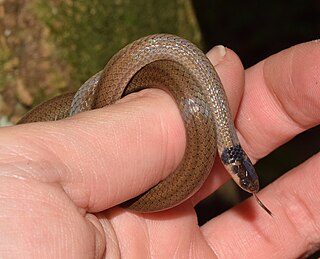
Sibynophis collaris, commonly known as the common many-toothed snake,Betty's many toothed snake or the collared black-headed snake, is a species of colubrid snake endemic to South and East Asia.

The smooth earth snake is a species of nonvenomous natricine colubrid snake native to the eastern half of the United States.

Micrelaps muelleri is a species of venomous rear-fanged snake in the family Lamprophiidae. The species is endemic to the Middle East.
Brachyophis is a monotypic genus created for the rear-fanged venomous snake species, Brachyophis revoili, commonly known as Revoil's short snake, which is endemic to Eastern Africa. Three subspecies are recognized as being valid.
Hypoptophis is a monotypic genus created for the rear-fanged (opisthoglyphous) venomous snake species, Hypoptophis wilsonii. The species, which is endemic to Africa, is in the subfamily Aparallactinae of the family Atractaspididae. There are no subspecies that are recognized as being valid.

Macrelaps is a monotypic genus created for the rear-fanged (opisthoglyphous) venomous snake species, M. microlepidotus, endemic to South Africa. No subspecies are currently recognized.
The Cameroon racer, Poecilopholis cameronensis, is a species of rear-fanged venomous snake endemic to Africa. Poecilopholis is a monotypic genus created for this species.
Aparallactus lineatus, or the lined centipede-eater, is a species of venomous rear-fanged snake in the family Atractaspididae.
Aparallactus niger is a species of venomous rear-fanged snake in the family Atractaspididae. It is endemic to Western Africa.
Polemon acanthias, or Reinhardt's snake-eater, is a species of venomous rear-fanged snake in the family Atractaspididae. It is endemic to Africa.
Polemon barthii, or the Guinea snake-eater, is a species of rear-fanged venomous snake in the family Atractaspididae. The species is endemic to Africa.

Polemon collaris, or the collared snake-eater, is a species of venomous rear-fanged snake in the family Atractaspididae. It is endemic to Africa.
Polemon gabonensis, or the Gaboon snake-eater, is a species of venomous rear-fanged snake in the family Atractaspididae. It is endemic to Africa.

Polemon notatus is a species of venomous rear-fanged snake in the family Atractaspididae. It is endemic to Africa.

Xenocalamus mechowii, or the elongate quill-snouted snake, is a species of venomous rear-fanged snake in the subfamily Aparallactinae of the family Atractaspididae. The species is endemic to Africa.

Aparallactus capensis, or the Cape centipede-eater, is a species of venomous rear-fanged snake in the Atractaspididae family.
Aparallactus jacksonii, or Jackson's centipede-eater, is a species of venomous rear-fanged snake in the family Atractaspididae.

Aparallactus modestus, or the western forest centipede-eater, is a species of venomous rear-fanged snake in the Atractaspididae family.
Aparallactus nigriceps, or the Mozambique centipede-eater, is a species of venomous rear-fanged snake in the family Atractaspididae.
Aparallactus werneri, or the Usambara centipede-eater, is a species of venomous rear-fanged snake in the family Lamprophiidae. The species is endemic to Tanzania.










